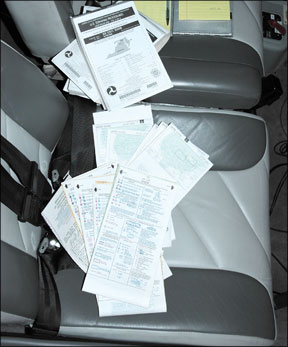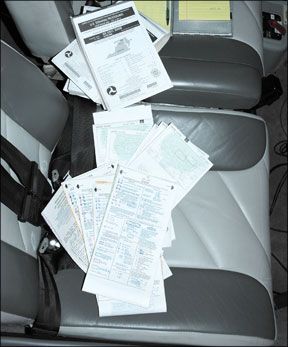If youre Instrument-rated and current, you almost certainly own at least a modest complement of IFR charts and approach plates. Of course, the odds are you still make a number of flights under VFR and, if youre like me, you probably always have a couple of current Sectionals in your flight bag. But many Instrument-rated pilots from time to time find themselves so accustomed to the IFR “system” that the idea of going VFR and not talking to someone seated at a radar scope gives 288 them the shakes. Also, flying a full VFR traffic pattern has been known to induce severe trauma in even the most jaded IFR pilots. Obviously, the well-rounded pilot needs to maintain proficiency in both realms. Sometimes, though its not so easy and making an effortless transition from one mode to the other requires more concentration than it should. Just like flying a taildragger like we were born in it or performing the perfect Lazy 8, an IFR pilots fluency and currency in VFR requires practice. First, though, and contrary to any inferences from this articles title, Im not going to advocate any inappropriate and potentially hazardous activity, such as its inverse, continuing VFR into IMC, nor would I condone the use of IFR charts by VFR pilots as the sole source for flight planning or navigation. Thats not to say many VFR-only pilots cant benefit from using instrument charts of one flavor or another in their routine operations. One glaring example is at night, when the low-altitude en route chart provides a wealth of concise information designed to keep you at an altitude guaranteed to avoid hitting anything other than another airplane. Different Philosophies Flying under Instrument Flight Rules can be quite demanding at times. At other times, aspects of IFR operations including planning and dealing with airspace-not to mention marginal VFR weather-can make IFR a walk in the park when compared to trying to complete the same trip VFR. Part of the reason is the IFR pilots enhanced familiarity with the National Airspace System that comes through earning the rating; part of it is simply how IFR flights are handled. When I got my Private certificate in 1990, the percentage of aviators holding an Instrument rating was somewhere around a third. Now it is close to half. One of the reasons more and more pilots are acquiring the IFR ticket involves increasing airspace complexity. If youre among those with an IFR ticket, none of this is news to you. But theres one aspect of flying in both the VFR and IFR worlds that may not have occurred to you: There are many advantages to using some of the information contained on VFR charts for your IFR flight planning. As a greater percentage of pilots earn Instrument privileges (or when, in the fullness of time, our airspace evolves and societal freedoms devolve to the point where not having an Instrument rating becomes a handicap), this will all become academic. At the present time, though, there are still two formats for visually presenting aeronautical information, one being primarily oriented towards literal portrayals for VFR, and the other involving much more symbolism. Charting The Differences Typically, pilots acquire a visually oriented skill set before continuing on to learn the ropes in the IFR world, i.e., you get your Private pilot certificate first, and then add the Instrument rating. That may not always be the case, however. One early result of such an evolution of the National Airspace System (as well as the broader phenomenon of the information revolution) is that budding pilots may not always be learning VFR skills first, and only later acquiring IFR skills. For example, that is exactly how pilots selected for the SAFER project in flight education research at Middle Tennessee State University learned: Its syllabus combined the rules of VFR flight with IFR procedures. For the present, though, we still mostly learn VFR before we discover IFR. Regardless of which you learn first, lets examine how the two charting formats might be combined during the flight-planning process to disclose some Greater Truths. The sidebar on page 10 explores but one example of how using a visual chart, in this case the Jacksonville Sectional, can help familiarize a transient pilot with his or her destination. By using the Sectional to identify various landmarks near an airport, we can get a much better idea of how to set up for our approach and what we can expect the destination airport to look like when it pops into view. Even in todays environment with color moving maps and databases automagically filling in the communications and navigation frequencies we might need, using a visual chart as a backup or as an enhancement to the instrument charts we normally carry provides huge benefits for the Instrument-rated pilot in situational awareness and operational flexibility. Airspace Another occasion when having the right VFR charts on board can pay major dividends is when ATC wants to re-route you because they dont want your FLIB in their airspace. Presuming you dont want the new routing-for whatever reason-whipping out the relevant Sectional or Terminal Area Chart can provide a wealth of information with no button pushing. For example, lets say youre transiting south of a major airline hub and its Class B airspace in the form of an inverted wedding cake. Youre comfortably cruising, anticipating a smooth letdown into your destination after a couple more hours. Regardless of your substantial distance from the Class Bs boundaries, the controller gives you a four-fix re-route even further south of your direct course, adding miles, fuel, headwinds and frustration to your day. This is when you have some choices: Accept the new routing and the additional trip time, cancel IFR and motor home VFR-perhaps air-filing another IFR flight plan on the other side-or request a VFR-on-top clearance, which often says to the facility you know more about clearances and separation than they do. With all but the first choice, a VFR chart will be really handy about now, because youll need to know the Class Bs dimensions, plus-especially if youve chosen to cancel IFR-what other airspace may be in your way. Using a VFR chart also offers a quick way to identify the Class B airspaces lateral and vertical limits, helping you to find a way to stay out of the monstrosity until you can hook back up with ATC on the other side. Yes, many moving-map-equipped GPS navigators can do much the same thing, but theres just no substitute for the blue, magenta and green confirmation in your hands that youre doing it right. Mountain Flying Flatland pilots like me dont venture very far into mountainous terrain very often. When we do, its with a healthy respect for the up- and downdrafts a windy day can bring with it. We usually carry some oxygen and try to keep the airplane light by restricting people, bags and fuel to help enhance airplane performance. Over such terrain, judicious use of a visual chart can help you avoid the worst of a mountainous areas weather. Think about it: On days when the not-so-good weather is only a high overcast with good visibility underneath, it might just be cold enough in those clouds to paste some ice on your wings. By staying lower, you can avoid the ice and the granite at the same time. Of course, the cloud bases have to be high enough to not only clear the terrain, but do so with margins safe enough to ensure you meet VFR cloud and visibility restrictions. But instrument charts dont have the information you really need to make this Plan B work. The airways, MEAs and MOCAs found on the low-altitude en route charts can be useful tools, but they dont tell you locations of the mountain peaks and passes, data you might need to safely conclude your flight. In any event, trying to blow through unfamiliar mountains in the kind of underpowered airplanes most of us fly can be, umm, exciting. A visual chart can provide the detail necessary to safely complete a flight that otherwise would have ended with a diversion. Some discretion is necessary, too. I hope Ive given you some food for thought here. Im certainly not advocating that we all go out and buy twice the number of charts were now using-and I can assure you that I havent gotten any kickbacks from chart publishers. More important, its easy for IFR pilots to forget much of what they learned early in their flying careers. We can easily return to those forgotten VFR skills and mindsets if we just take a few moments to think about where we are, what were doing and whos nearby.




